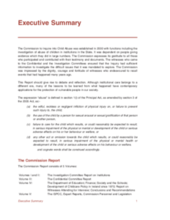Tens of thousands of Irish children were sexually, physically and emotionally abused by nuns, priests and others over 60 years in a network of church-run residential schools meant to care for the poor, the vulnerable and the unwanted. The Commission to Inquire into Child Abuse released their 2,600-page report in May 2009 which paints a picture of institutions characterized by privation and cruelty that could be both casual and choreographed.
The report, by a state-appointed commission, exposes for the first time the scope of the problem in Ireland, as well as how the government and the church colluded in perpetuating an abusive system. The report is based in part on old church records of unreported abuse cases and in part on the anonymous testimony of 1,060 former students from a variety of 216 mostly church-run institutions, including reformatories and so-called industrial schools, set up to tend to neglected, orphaned or abandoned children. Some 30,000 children were sent to such places over six decades, the report says, often against their families’ wishes and because of pressure from powerful local priests. They were sent because their families could not afford to care for them, because their mothers had committed adultery or given birth out of wedlock, or because one or both of their parents was ill, drunken or abusive. They were also sent because of petty crime, like stealing food, or because they had missed school.
The report, by a state-appointed commission, exposes for the first time the scope of the problem in Ireland, as well as how the government and the church colluded in perpetuating an abusive system. The report is based in part on old church records of unreported abuse cases and in part on the anonymous testimony of 1,060 former students from a variety of 216 mostly church-run institutions, including reformatories and so-called industrial schools, set up to tend to neglected, orphaned or abandoned children. Some 30,000 children were sent to such places over six decades, the report says, often against their families’ wishes and because of pressure from powerful local priests. They were sent because their families could not afford to care for them, because their mothers had committed adultery or given birth out of wedlock, or because one or both of their parents was ill, drunken or abusive. They were also sent because of petty crime, like stealing food, or because they had missed school.
Many of the former students said that they had not learned their own identities until decades later. They also said that their parents had unsuccessfully tried to reclaim them from the state.
Key findings, documented in the Executive Summary, revealed that:
-
The Confidential Committee heard evidence from 1090 men and women who reported being abused as children in Irish institutions. Abuse was reported to the Committee in relation to 216 school and residential settings including Industrial and Reformatory Schools, Children’s Homes, hospitals, national and secondary schools, day and residential special needs schools, foster care and a small number of other residential institutions, including laundries and hostels.
-
More than 50% of witnesses who were in out-of-home care placements for substantial periods of their childhood were first admitted when they were less than 5 years old and their average length of stay in out-of-home care was 9 years.
-
Witnesses reported being physically, sexually and emotionally abused, and neglected by religious and lay adults who had responsibility for their care, and by others in the absence of adequate care and supervision. Many of the 216 named settings were the subject of repeated reports of abuse. In excess of 800 individuals were identified as physically and/or sexually abusing the witnesses as children in those settings. Neglect and emotional abuse were often described as endemic within institutions where there was a systemic failure to provide for children’s safety and welfare.
-
More than 90% of all witnesses who gave evidence to the Confidential Committee reported being physically abused while in schools or out-of-home care.
-
Emotional abuse was reported by witnesses in the form of lack of attachment and affection, loss of identity, deprivation of family contact, humiliation, constant criticism, personal denigration, exposure to fear and the threat of harm.
-
Children with learning disability, physical and sensory impairments and children who had no known family contact were especially vulnerable in institutional settings.
-
In conclusion, the Confidential Committee heard evidence that children were severely abused and neglected by those with responsibility for their safety and welfare. Those in care without family contact and with special needs were most at risk. Witnesses reported that the abuse experienced in childhood had an enduring impact on their lives.
-
The system of large-scale institutionalisation was a response to a nineteenth century social problem, which was outdated and incapable of meeting the needs of individual children. The defects of the system were exacerbated by the way it was operated by the Congregations that owned and managed the schools. This failure led to the institutional abuse of children where their developmental, emotional and educational needs were not met.

